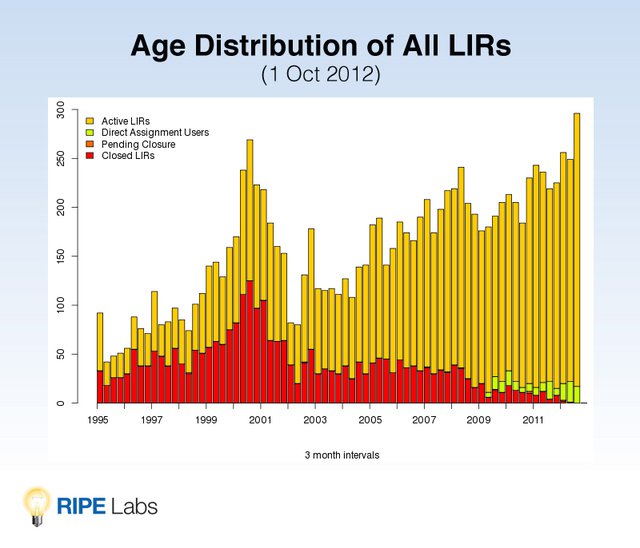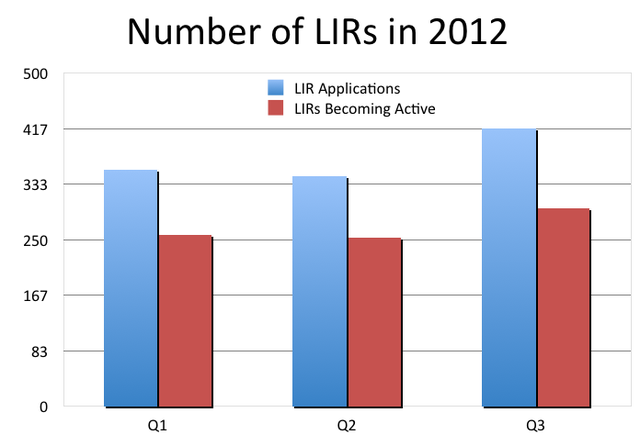We observed an increase in the number of new LIRs in the RIPE NCC service region. Many of these new LIRs show 1-star IPv6 RIPEness.
The RIPE NCC’s membership grew steadily over the course of 2012. In Q3 2012 the RIPE NCC received 417 requests to become a Local Internet Registry (LIR). That is the highest number we have seen so far. It even exceeds the previous record that was set 12 years ago during the dot com bubble in 2000.

One reason for the surge is probably the anticipation of the last /8 of IPv4 addresses. The RIPE NCC reached the last /8 of IPv4 address on 14 September 2012 (see RIPE NCC is Reaching the Last /8 of IPv4 ). (Note that this graph also shows the number of Direct Assignment Users (DAUs) in light green, because they are also included in the IPv6 RIPEness measurements below).
If we look at the number of new LIR applications and the number of LIRs that became active in Q3 2012, it becomes even more obvious.

Figure 2 shows that the number of LIR applications the RIPE NCC received in 2012 (blue), has increased significantly over the last few months. It is also interesting to note that more LIRs finalised the process of becoming active (red). Almost 300 LIRs finalised the process and became active in Q3. This process usually takes a longer period of time.
We also looked at the IPv6 RIPEness of these new LIRs and DAUs and found that the group of LIRs that joined the RIPE NCC during the last quarter, has the highest score of 1-star IPv6 RIPEness. That means they received an IPv6 allocation from the RIPE NCC. The yellow bar in Figure 2 indicates the number of LIRs that started in this particular quarter and that have an IPv6 allocation.

You can see that the numbers for Q3 2012 look very different from the previous months. New LIRs usually lag a bit behind in getting an IPv6 allocation as we described in IPv6 RIPEness - Sorted by LIR's Age and Size . This recent increase could be caused by the requirements for IPv4 address space allocated from the last /8 which the RIPE NCC started allocating from in September: An LIR can only request IPv4 address space if they can justify the need for it and if they already have an IPv6 allocation. This requirement was set by the RIPE community in order to promote the deployment of IPv6.
It will be interesting to see if these LIRs will also reach the other IPv6 RIPEness stars. Will these LIRs also be fast in announcing and using their IPv6 allocation?





Comments 1
The comments section is closed for articles published more than a year ago. If you'd like to inform us of any issues, please contact us.
Lutz Donnerhacke •
How surprising. Did anybody expect anything else? Despite more applications per months? So let's sing together: Burn, venture ca^W^Wlegacy address! Burn!